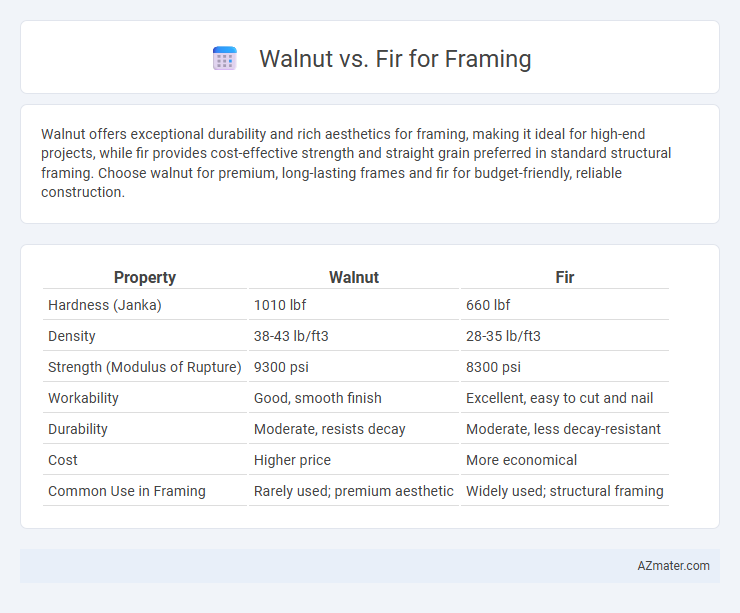Walnut offers exceptional durability and rich aesthetics for framing, making it ideal for high-end projects, while fir provides cost-effective strength and straight grain preferred in standard structural framing. Choose walnut for premium, long-lasting frames and fir for budget-friendly, reliable construction.
Table of Comparison
| Property | Walnut | Fir |
|---|---|---|
| Hardness (Janka) | 1010 lbf | 660 lbf |
| Density | 38-43 lb/ft3 | 28-35 lb/ft3 |
| Strength (Modulus of Rupture) | 9300 psi | 8300 psi |
| Workability | Good, smooth finish | Excellent, easy to cut and nail |
| Durability | Moderate, resists decay | Moderate, less decay-resistant |
| Cost | Higher price | More economical |
| Common Use in Framing | Rarely used; premium aesthetic | Widely used; structural framing |
Introduction: Walnut vs Fir for Framing
Walnut and fir differ significantly in framing applications due to their distinct properties. Fir, especially Douglas fir, is preferred for framing because of its high strength-to-weight ratio, stability, and affordability, making it ideal for structural support. Walnut, being a hardwood, is denser and more expensive, often reserved for decorative trim rather than primary framing.
Overview of Walnut and Fir Wood
Walnut wood, prized for its rich color and fine grain, offers moderate strength with excellent stability, making it suitable for high-end furniture rather than heavy framing. Fir wood, specifically Douglas Fir, is commonly used in framing due to its superior strength, stiffness, and availability, providing reliable structural support in construction. While walnut excels in durability and aesthetic appeal, fir dominates framing applications because of its cost-effectiveness and mechanical properties.
Strength and Structural Integrity Comparison
Walnut offers moderate strength but is generally less suitable for framing compared to fir, which provides superior structural integrity due to its higher density and stiffness. Fir's high load-bearing capacity and resistance to warping make it the preferred choice for framing where durability is critical. Walnut's aesthetic appeal and hardness are better suited for finishing work rather than structural framing applications.
Durability and Longevity
Walnut offers moderate durability with natural resistance to decay, making it suitable for framing in environments with less moisture exposure; however, its higher cost limits its common use. Fir is highly durable, known for its strength and resistance to warping and splitting, providing excellent longevity in construction framing applications. Fir's consistent structural integrity and affordability make it the preferred choice for durable framing projects.
Workability and Ease of Construction
Walnut offers a durable and dense grain that enhances structural integrity but requires more effort to cut and shape, impacting workability during framing. Fir, being softer and lighter, provides superior ease of construction with clean nailing and cutting, making it a preferred choice for efficient framing projects. The workability of fir reduces labor time and tool wear, while walnut's hardness necessitates specialized tools for precise assembly.
Cost Differences and Budget Considerations
Walnut framing typically costs significantly more than fir due to its premium hardwood status and dense grain, making it less common for structural framing but favored for aesthetic projects. Fir is widely used in framing because of its affordability, availability, and sufficient strength, presenting a budget-friendly option for large-scale construction. When budgeting, choosing fir reduces overall expenses without compromising structural integrity, while walnut is better suited for specialized projects where cost is secondary to appearance.
Sustainability and Environmental Impact
Walnut wood, known for its durability and rich color, is less sustainable for framing due to slower growth rates and higher harvesting impact compared to fir. Fir, particularly Douglas fir, is a more eco-friendly choice as it grows faster and is widely available from managed forests, ensuring better carbon sequestration and reduced deforestation. Choosing fir for framing supports sustainable forestry practices and minimizes the environmental footprint associated with construction projects.
Aesthetics and Visual Appeal
Walnut offers a rich, dark brown color with intricate grain patterns that enhance framing aesthetics, making it ideal for high-end or decorative projects. Fir, with its light reddish tones and straight grain, provides a clean and uniform appearance better suited for minimalist and rustic framing styles. The choice between walnut and fir depends on the desired visual impact, with walnut delivering warmth and sophistication, while fir offers simplicity and subtlety.
Common Uses in Framing Applications
Walnut is rarely used for framing due to its high cost and dense hardwood properties, making it more suitable for fine furniture and decorative accents rather than structural applications. Fir, particularly Douglas Fir, is widely favored for framing in construction because of its strength, straight grain, and affordability, providing excellent support in residential and commercial building frameworks. Fir's availability and load-bearing capacity make it a standard choice for wall studs, floor joists, and roof rafters, while walnut remains primarily a specialty wood in woodworking sectors.
Conclusion: Choosing Between Walnut and Fir for Framing
Walnut offers superior durability and aesthetic appeal with its rich color and tight grain, making it ideal for high-end framing projects where visual impact is crucial. Fir provides excellent strength-to-weight ratios, cost-effectiveness, and stability, which suits structural framing and budget-conscious applications. Selecting between walnut and fir ultimately depends on whether the priority is decorative quality or structural efficiency in framing.

Infographic: Walnut vs Fir for Framing
 azmater.com
azmater.com